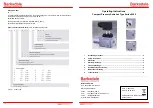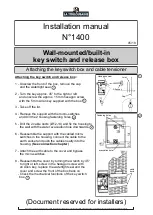
Code Operated Matrix Switch
6
controlled electronic switch. It allows any of its
ports to communicate with any other connected
port, or any pair of ports to communicate
simultaneously.
For example, a number of terminals or
computers can share several peripheral devices,
such as printers or modems. A simple code from
any terminal or computer links it to the desired
peripheral.
Here’s another application: one computer is
connected to a laser printer, while another
computer is simultaneously connected to a dot-
matrix printer. Later, the printers could be swapped
(as in an X-switch configuration) without the need
to change or move any cables.
The standard Code Operated Matrix Switch has
five ports that support any combination of input,
output, or bidirectional devices. The Switch has 32K
of RAM with approximately 31K devoted to
buffering. The 4-Port Expansion Board
(Model SW541-C) provides four additional
input/output ports (see
Appendix B
for
instructions on setting it up).
This manual includes a quick-reference section,
Appendix C
. If you’re familiar with the operation of
the COMS, use the charts in that section to set up
the Switch. If not, proceed through Sections 3, 4,
and 5.
NOTE: This manual will take you through installa-
tion, operation, and troubleshooting for the
Code Operated Matrix Switch in both the
five-port and nine-port versions. See
Appendix B for instructions on setting up
the 4-Port Expansion Board.
You’ll need an edged or pointed object small
enough to set DIP switches to install the Switch.
These are the steps to follow for installation:
1. Set the internal option DIP switches.
2. Configure shunt jumpers for DTE or DCE.
3. Connect devices to the switch ports.
4. Supply power to the Code Operated Matrix
Switch.
2. Introduction








































